In this post, students of the TESOL (Teaching English to Speakers of Other Languages) MA at the University of Birmingham blog about the CLiC Web App as a language learning resource. This post originated from a task set by Dr Viola Wiegand and Dr Paul Thompson for ‘Corpus-Assisted Language Learning’, a TESOL module that encourages students to apply corpus linguistic tools and resources to English language teaching. Many thanks to Weiqing Chu, Luyi Wang, Miaoting Wu and Xinzu Li for their fantastic contribution. You can download the worksheets referenced here.
One afternoon in the Corpus-Assisted Language Learning class, Dr Viola Wiegand introduced us to the CLiC Web App (Mahlberg et al 2020) and assigned us the task of running a concordance search for a specific word in one classic work of fiction. Following Dr Wiegand’s instructions, we gradually uncovered the magic of the CLiC resource. CLiC blends the merits of corpus-assisted learning as well as literature-assisted learning. Students are free to search across whichever literature they are most interested in, and then conduct further concordance searches to expand their vocabulary, and enhance their reading skills (Johns, 1991). As such, students are truly regarded as travellers, researchers, or detectives, in keeping with the slogan ‘Every student is a Sherlock Holmes’ (Gilquin & Granger, 2010). With this philosophy in mind, we set out to design a vocabulary class assisted by the CLiC Web App.
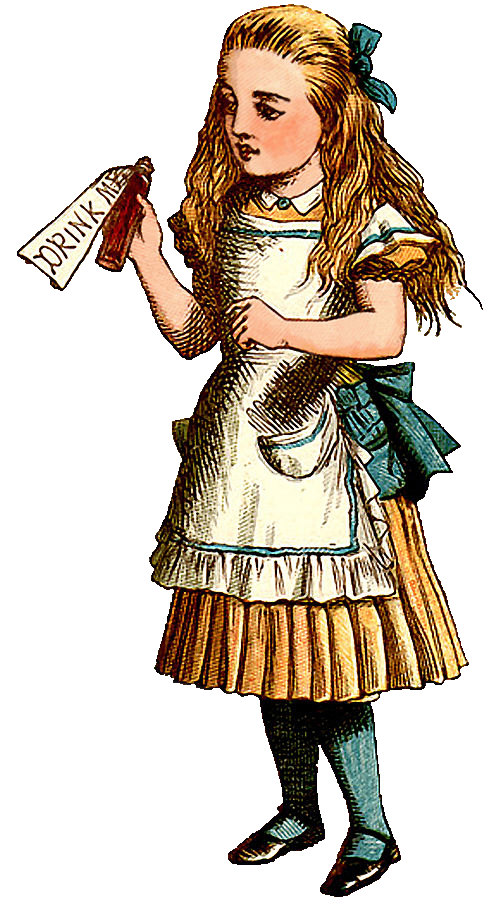
The use of CLiC was initially proposed by our group members in a corpora project on our course ‘Corpus Assisted Language Learning’. The purpose of the project was to design activities about polysemy by using corpora for a specific teaching situation. We designed our activity around teaching 20 university students of English language and literature who aimed to become English teachers in the future.
The CLiC Web App consists of a plethora of literary texts which constitute corpora files for users to search. The texts can be selected individually or combined freely for analysis using any of CLiC’s tools. CLiC proves a useful tool for designing activities for literature students to enrich their teaching experience in the future.
Alice’s Adventures in Wonderland by Lewis Carroll (1865) is categorized as a fantasy novel that depicts a girl named Alice who falls through a rabbit hole into a magical world of many illogical and strange creatures. It has long been enjoyed by both children and adults owing to its sense of playful absurdity. Considering its wide acceptance among adults and children alike, we decided to select it as our chosen text.
Warm-up Activity: The use of feet across Alice’s Adventures in Wonderland
In order to choose a word to demonstrate the polysemy in this novel, we began with the word feet. The word feet is closely related to the plot of the novel and appears in different stages of the novel. Throughout Alice’s adventures in Wonderland her body size changes unexpectedly: from growing as tall as a house to shrinking to 3 inches. As figure 4 shows, there are nineteen concordance lines displaying different meanings of feet which could be used for examples in the activity.
The first meaning of feet in this novel is as a body part (as in the collocations little feet, one’s own feet, and rising to one’s feet). The second meaning of feet is as a unit of measurement, (as in the collocation nine feet high).
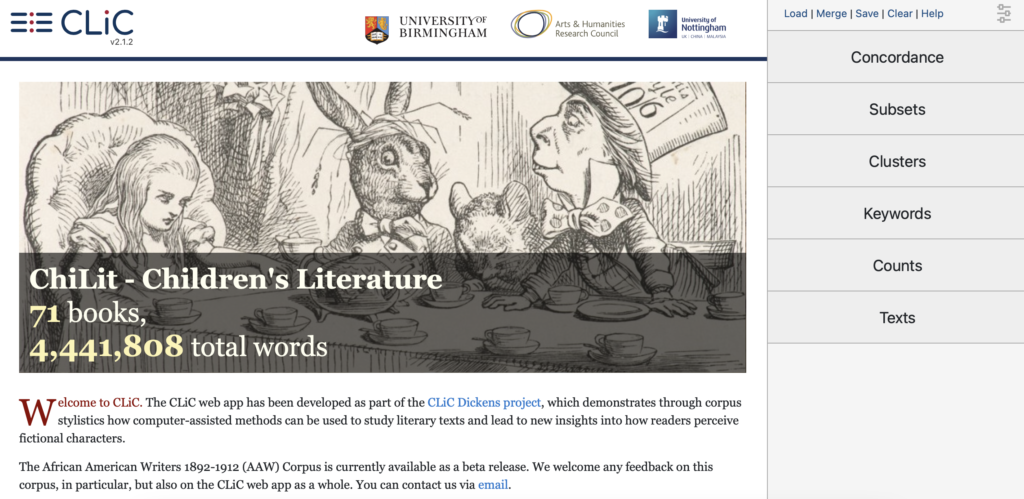
This activity mainly follows three steps:
Step 1 is to give students a synopsis of the novel and explain the polysemous use of feet across the text.
Step 2 is to demonstrate how to use CLiC to search feet within Alice’s Adventures in Wonderland as outlined below:
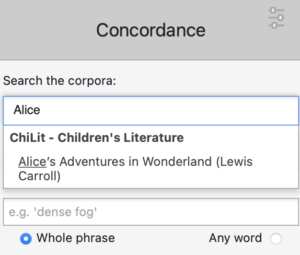
- Enter the URL https://clic.bham.ac.uk/
- From the landing page (Figure 2) students can then click on the ‘concordance’ tab which is on the first of the analysis tabs on the top right of the page to start the search and enter ‘Alice‘ or ‘Alice’s Adventures in Wonderland‘ to select the specific text (the search process can be seen in Figure 3).
- Enter feet under ‘search for the terms’ in the concordance tab. Figure 4 illustrates the concordance search results.
Step 3 is to observe the meanings and collocations of feet through the 19 concordance lines and encourage students to share findings with their partners.
Generally, this activity gives learners an overview of how to use the CLiC corpora by analyzing the polysemy of feet contextually in the novel.
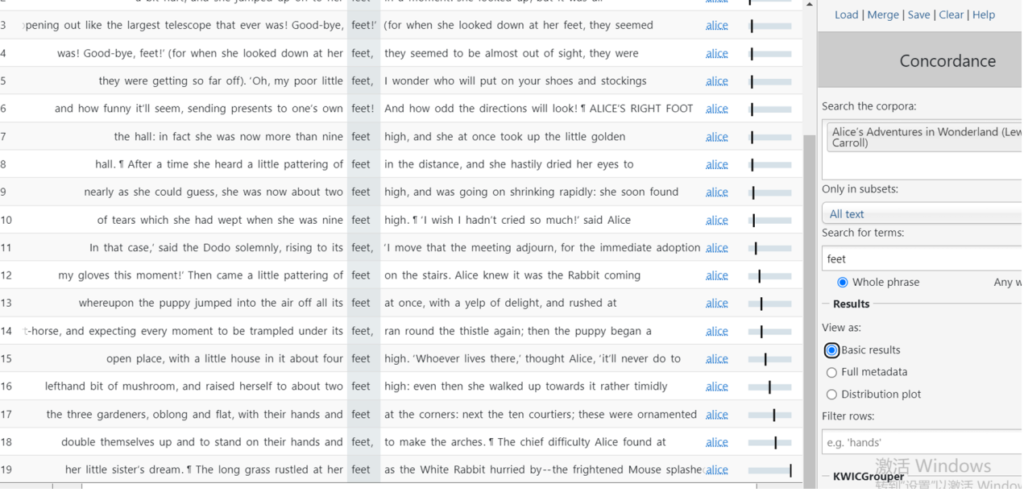
Activity one: The use of found in Alice’s Adventures in Wonderland
The aim of this activity is to heighten students’ awareness of vocabulary and how words can have multiple meanings. Aitchison (2012) defines polysemy as ‘the so-called “layering” of relatedness of meaning accompanying identical form, in which one form (written or spoken) [has] multiple meaning, all related by extension.’ In other words, all the meanings of one word are related and mutually created. To help students better understand polysemy, we designed the task as follows. There are three steps for teachers to carry out. First, give each student a worksheet prepared before class to fill in for about 5 minutes. The worksheet has been listed below (see figure 5) and can be downloaded here. All the sentences are extracted from Alice’s Adventures in Wonderland. Students need to fill in the blank with an appropriate word according to the context.
For example, in the first sentence, students might want to fill in a word like thought or considered. In the next sentence, students might want to write down a word like discovered or found. There are many different answers according to the contexts.
Next, students are divided into five groups. They should discuss their answers and try to complete all five sentences with the same word. This task can last for 8 minutes.
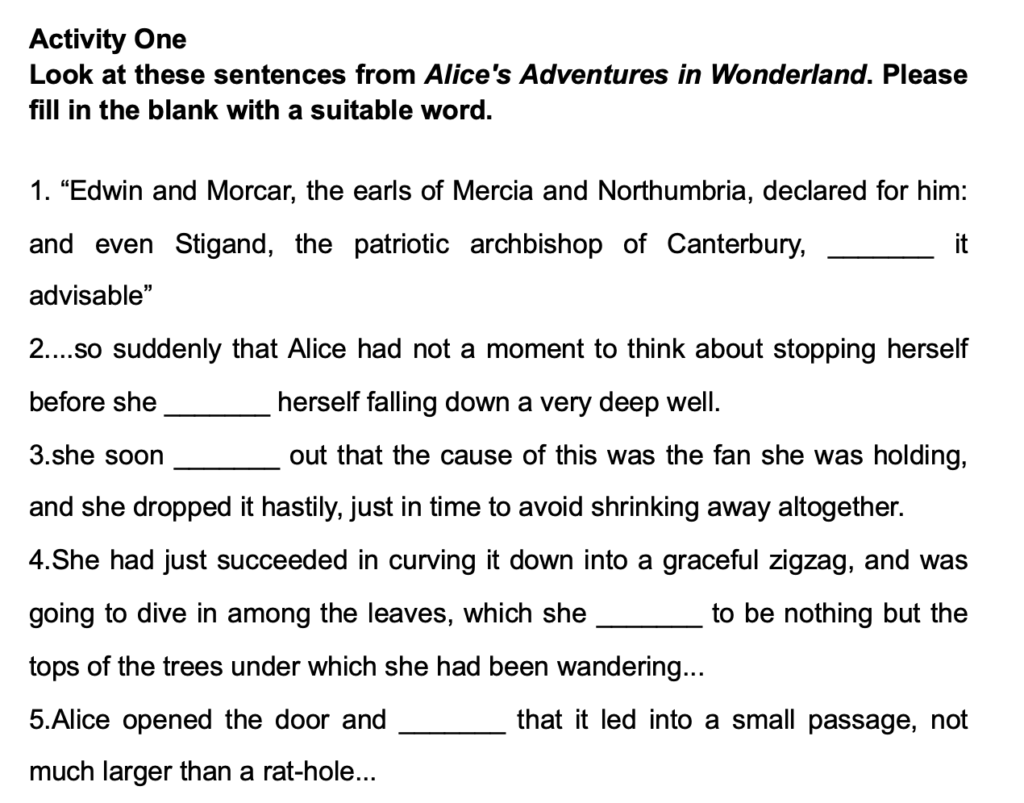

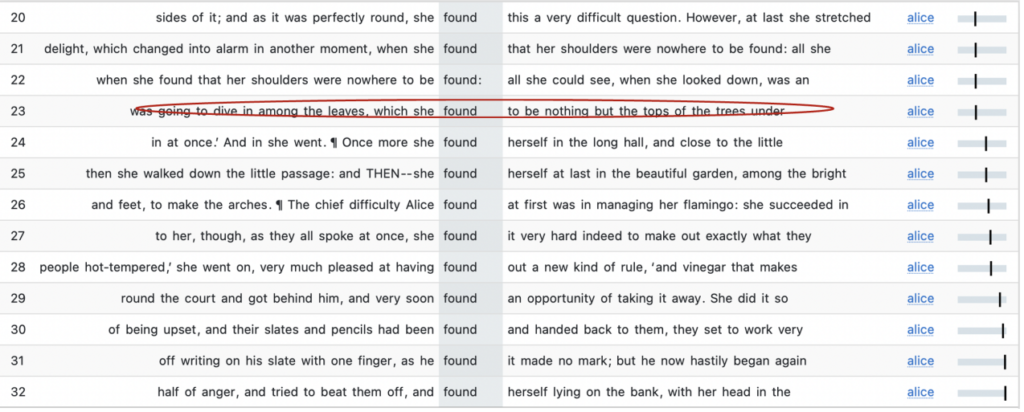
Students could summarize some patterns, collocations and phrases from these. This step can last for 10 minutes. Notes could be taken like this:
Notes: a. Find it + adj. (10、13、27)
b. Find oneself doing sth. (1、16、32)
c. Find out (9、28 )
d. Find that… (3、8、21)
In this way, students can better grasp the common usages of found. The extract from Alice’s Adventures in Wonderland makes this activity more interesting by involving students and allowing them to explore multiple meanings. Additionally, the contextual use of familiar literature makes these activities less intimidating and more accessible for students.
Bonus Exercise:
As a bonus exercise (for students after class) students can be tasked with creating their own short story about growing up using found-related combinations.
Activity Two: The use of curious in Alice’s Adventures in Wonderland
The aim of this activity is to increase students’ awareness of vocabulary and enrich their understanding of how words can have multiple meanings in different contexts. We will use a deductive and hands-on approach in this activity. The key word we selected for this activity is curious. According to the online Oxford Learners’ Dictionaries, there are two main meanings of curious. The first one means having a strong desire to know about something e.g. ‘he is such a curious boy, always asking questions’. The second one means “strong and unusual” e.g. ‘it was a curious feeling, as though we were floating on air.’ The reason we chose curious as a keyword in this activity is that it has another unfamiliar meaning in literature. When we talk about curious, we normally refer to the first meaning – “strong desire”. However, in Alice’s Adventures in Wonderland, we can see that it refers more to the second meaning – “strange and unusual”. We will see evidence from the concordance lines later in this section. Additionally, in order to decide which meanings are in a sentence, we need to analyse the sentences in context.
- Step 1 The teacher starts the activity by asking students what curious normally means and how many meanings they think it might have (3 minutes)
- Step 2: Students work in groups of 3-4 and use a dictionary to find out the meanings of curious (10 minutes)
- Step 3: Students work in groups and search concordances of curious in Alice’s Adventures in Wonderland in CLiC, then verify and match concordance lines with the meanings of curious they find in the dictionary (15 minutes).
- Step 4: The teacher invites students to share their results and findings in groups (10 minutes).

19 concordance lines with the keyword curious will appear. Students then can work on these 19 concordance lines and analyze the meaning of curious for each sentence. Students might find that concordance lines 2, 5, 17 and 19 have the first meanings (strong desire) and the rest of them mean “strange and unusual”.
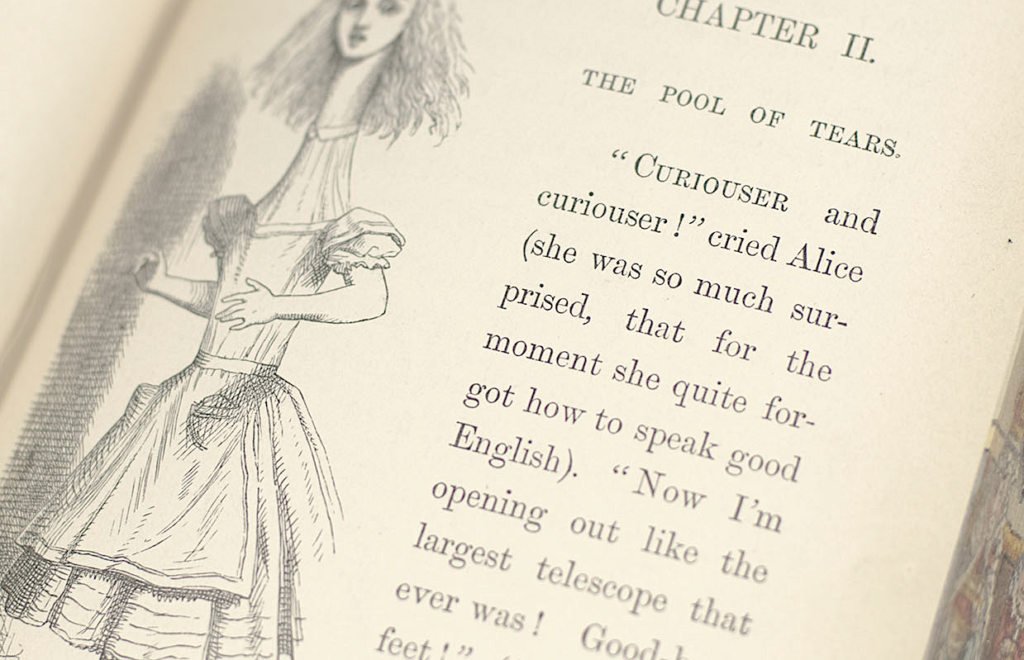
Alternative-Inductive & Hands-on Approach
A deductive way of teaching is suitable for many teaching situations. To meet other learners’ needs, we also design an alternative approach using an inductive and hands-on approach. Inductive learning, also known as discovery learning, is a process where the learner discovers rules by observing examples.
- Step 1: Guess. The teacher asks students what curious normally means and how many meanings they think it might have (3 minutes).
- Step 2: Search & investigate. Students work in groups and search concordances of curious in Alice’s Adventures in Wonderland in CLiC and investigate how many meanings it has (15 minutes).
- Step 3: The teacher asks students to share their findings (5 minutes).
- Step 4: The teacher asks students to check in the dictionary to verify their findings (15 minutes).
- Step 5: Students go back to concordances to check their previous findings (10 minutes).
- Step 6: The teacher comments and gives answer keys (5 minutes).
Bonus Exercise:
Students work in groups again and repeat the previous steps to look up the word fancy in CLiC.
Advantages of this Approach
This design combines CLiC with vocabulary-teaching, a modern method that can not only help students have a deeper understanding of polysemy, but also serves as a fun activity that encourages students to explore the vocabulary by themselves. Secondly, as Gilmour (2017) suggests, using literary classics can and should reflect on students’ experience of linguistic diversity, and turn this experience into a tool for self-reflection. With the help of a work of literature whose plots are already familiar, students can concentrate more on language usage.
Limitations
However, there are also some limitations, for example, students’ cognitive level and their mastery of computer skills vary — their learning pace might consequently be different. This method, therefore, might require more attention from the teacher to individual students in order to balance the teaching pace. Another limitation is that, since this lesson is designed for use with one specific work of literature, there is a risk that certain expressions might stand in for one writer’s style. So, students must be encouraged to read more works and carry out comparable exercises.
References
-
Aitchison, J., (2012). Words in the Mind: An Introduction to the Mental Lexicon. 4th ed. UK: Wily- Blackwell.1 Al-Sulaimaan, M., 2016. Semantics and Pragmatics. Erbil: Lebanese French University.
-
Carroll, L., (1865). Alice’s Adventures in Wonderland. New York: Macmillan.
-
Gilmour, R. (2017). Reading/Writing Multilingualism: language, literature and creativity in the multilingual classroom. English in Education, 51(3), 296-307.
-
Gilquin, G., & Granger, S. (2010). How can data-driven learning be used in language teaching?. The Routledge Handbook of Corpus Linguistics, 359-370.
-
Johns, T. (1991). Should you be persuaded: Two samples of data-driven learning materials Classroom Concordancing: ELR Journal, (4), 1-16.
-
Mahlberg, M., Stockwell, P., Wiegand, V., & Lentin, J. (2020). CLiC 2.1. Corpus Linguistics in Context, available at: clic.bham.ac.uk.
-
Manning, S. J. (2019). Using a Corpus for Post-writing Corrective Feedback on Word-choice Errors.Humanising Language Teaching. 21 (6), 1-1.
-
Oxfordlearnersdictionaries.com. (2022). curious adjective – Definition, pictures, pronunciation and usage notes | Oxford Advanced Learner’s Dictionary at OxfordLearnersDictionaries.com. [online] Available at: https://www.oxfordlearnersdictionaries.com/definition/english/curious?q=curious [Accessed 12 Apr. 2022].
Please cite this post as follows: (2022) Chu, W., Wang, L., Wu, M. and Li, X. How can CLiC be used to teach English? Polysemy in Alice’s Adventures in Wonderland [Blog post]. CLiC Fiction Blog, University of Birmingham. Retrieved from [https://blog.bham.ac.uk/clic-dickens/2022/07/27/alicepolysemy/]

Join the discussion
0 people are already talking about this, why not let us know what you think?